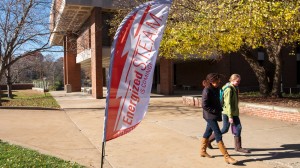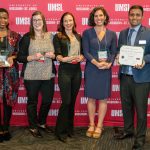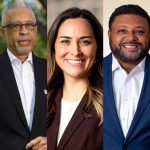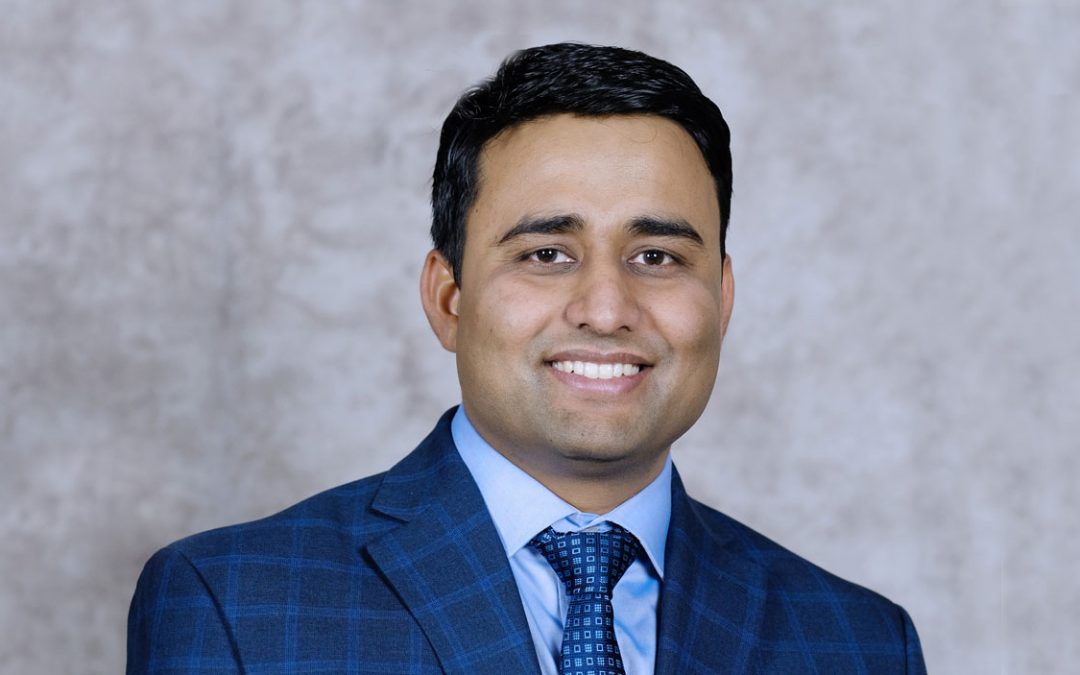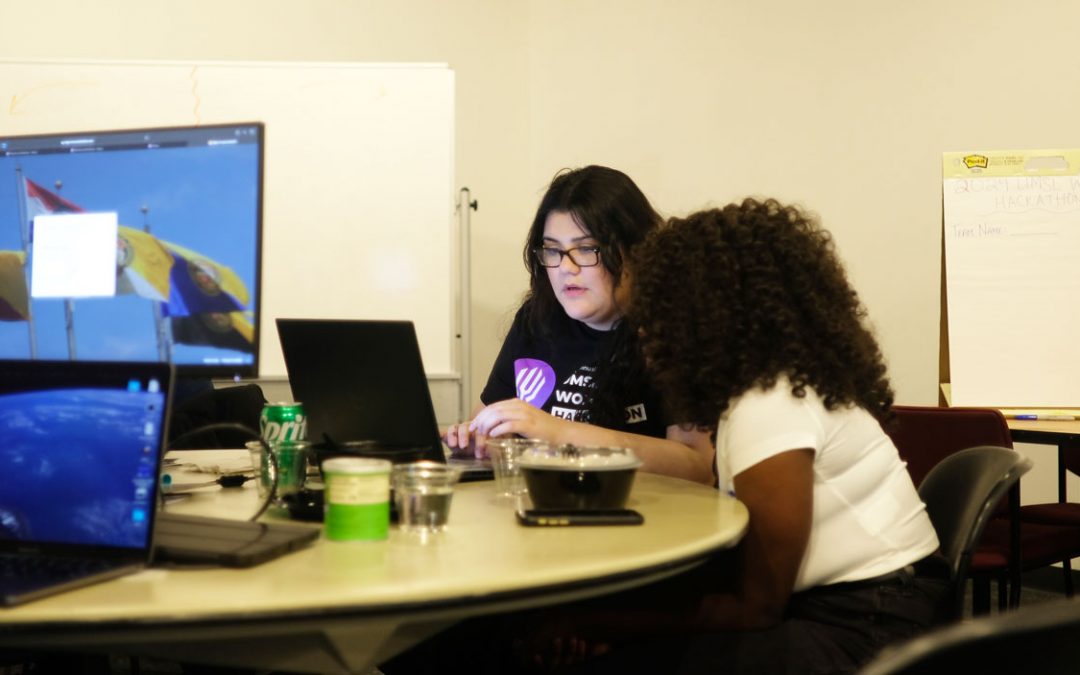
Ron Yasbin, dean of the College of Arts and Sciences, talks with Kiera Hall (second from left), a prospective student from Kansas City, Mo., and Kiera’s mother, Tonya Hall (far left), while Rachel Boehlow, assistant director in Career Services, looks on. (Photos by August Jennewein)
As people rely more heavily on technology, Ron Yasbin believes interdisciplinary studies will be the future of higher education.
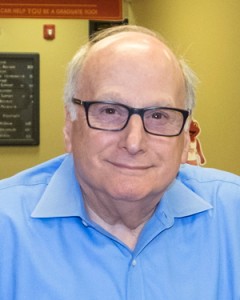
Ron Yasbin is the dean of the College of Arts and Sciences at UMSL.
“Our society is becoming more interdisciplinary,” says Yasbin, dean of the College of Arts and Sciences at the University of Missouri–St. Louis. “If you’re doing art, there’s now technology involved and data in your artwork.”
And he feels that moving the College of Fine Arts and Communication back into the College of Arts and Sciences on Jan. 1 will help foster that approach at UMSL.
UMSL Daily recently sat down with Yasbin to shed some light on the new additions to the College of Arts and Sciences and those Energize STEAM flags that have popped up across campus.
First, can you provide a little history of the two colleges?
The College of Fine Arts and Communication began about 16 years ago. It was composed of academic programs that were part of the College of Arts and Sciences. While they became two freestanding colleges, they remained joined at the hip, so to speak. For example, the CAS advising unit handles both colleges with the associate deans reporting equally to each college’s dean. So there has been cooperation between the two colleges over the years, but the amount of true interdisciplinary interactions have not fully matched the potential.
What changes can be anticipated with the College of Fine Arts and Communication returning to the College of Arts and Sciences?
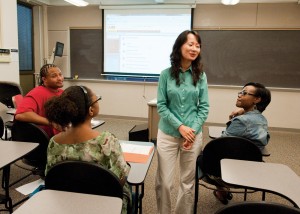
Yan Tian, associate professor of communication, teaches a graduate-level course at UMSL. The Department of Communication will remain a freestanding department when it returns to the College of Arts and Sciences on Jan. 1.
The Department of Communication will remain a freestanding department in the College of Arts and Sciences. It will include the media studies program. The rest of the College of Fine Arts and Communication programs – studio art, art history, music, theatre and dance – will become the School of Fine and Performing Arts umbrellaed under CAS. I anticipate naming a director of the school before the end of the year. By merging the colleges, we also have the potential to dramatically increase interdisciplinary course offerings as well as programs. For instance, a new course titled The Chemistry of Art is scheduled to be taught this spring. The faculty is already working on interactions between math and music. We envision cooperation between media studies and the astronomers, as well as strong growth of the bachelor of liberal studies and the bachelor of interdisciplinary studies degrees.
How will the combining of the two colleges benefit students?
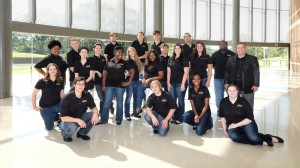
UMSL performance group Vocal Point will now be housed under the School of Fine and Performing Arts in the College of Arts and Sciences at UMSL.
Greatly. Basically, the College of Fine Arts and Communication, as it existed, was relatively small. Now the new College of Arts and Sciences will have half the students enrolled at the university. It will help us in talking to students more about dual majors and minors. A lot of science students, for example, are very interested in the performing arts. Just look at our chancellor. He’s an internationally recognized scientist, but he’s also a renowned jazz pianist. Well, there was a bit of a barrier between the sciences and fine arts before, and this will wipe that out. We want our students to easily achieve the whole education they desire.
So they’ll have greater access to a more comprehensive education?
Absolutely. There will be more interdisciplinary approaches to seeking a degree through our college. We’ve seen a huge growth in our liberal studies and interdisciplinary studies degree offerings. We think with the new size and diversity of offerings from within the college, we’re going to witness even more students wanting to develop a specific degree that we might not offer but best fits their career pursuits. And we’re encouraging that. These are not watered-down degrees. They tend to be very demanding, but they’re also very exciting to the students. They better fit the 21st century employment offerings. This approach will also contribute to our plan to becoming a leading institution for the offering of creative courses and programs that emphasize the STEAM disciplines. You’ve seen our STEAM flags around campus?
I have. What is STEAM?
It stands for sciences, technology, engineering, arts and humanities and mathematics. STEAM is fast becoming a national movement that is replacing the emphasis formerly placed on the STEM disciplines. There seems to be desperation in the United States to get more students into the STEM disciplines. But there’s also a fear that focusing education solely on science, technology, engineering and mathematics would not lead to well-rounded students who were also enriched in the arts and humanities. STEAM works to better expose science majors to the humanities and fine arts majors to the sciences. Take the forthcoming Chemistry of Art course, which puts together basic scientific principles for people who are more into arts and humanities. We’re going to be doing a combination math course that incorporates music because music is based on math. We’re looking at more of these interdisciplinary type approaches because we’ve already done beer brewing as a way of getting students interested in science. And we have a math course that’s taught by the philosophers. It’s called Choices and Chance. The students don’t realize they’re getting a hard course in statistics and probability. But that’s OK; they’re enjoying it. It’s been a great success, and we’re going to be doing more of this between the arts and the sciences. This is the future of education. We’re at the forefront of that movement.
We’ve talked a lot about how the changes to the colleges will affect the students. But what about the faculty?
The College of Arts and Sciences has numerous programs for faculty – and students – that the College of Fine Arts and Communications faculty and students will able to tap into now. For example, UMSL Daily has had stories about our undergraduate research and scholarship program. The fine arts and communication students will be eligible for that. We also have a faculty research grant program that will be open to all of our new faculty members too. They’ll also be eligible for our curriculum grant program for proposing interdisciplinary courses and creating new approaches to teaching. And we have a travel grant program and visiting scholar program for CAS faculty. There’s going to be a lot of exciting opportunities for all of the fine arts and communication faculty and students who will soon call the College of Arts and Sciences their academic home.

